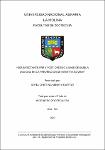Mostrar el registro sencillo del ítem
Desinfectante pre y post-ordeño a base de sábila (Aloe vera) en la prevención de mastitis bovina
| dc.contributor.advisor | Souza de Abreu, Maria Helena | |
| dc.contributor.advisor | Vargas Morán, Jorge Rafael | |
| dc.contributor.author | Minaya Duffoó, Sofía Cristina | |
| dc.date.accessioned | 2023-04-20T17:54:56Z | |
| dc.date.available | 2023-04-20T17:54:56Z | |
| dc.date.issued | 2023 | |
| dc.identifier.uri | https://hdl.handle.net/20.500.12996/5763 | |
| dc.description | Universidad Nacional Agraria La Molina. Facultad de Zootecnia. Departamento Académico de Producción Animal | es_PE |
| dc.description.abstract | La antisepsia de los pezones, tanto pre-ordeño como post-ordeño, previene infecciones intramamarias. El objetivo del estudio fue evaluar el efecto de la sustitución de un desinfectante de pezones comercial de iodo (7 000 ppm), pre y post-ordeño, por el extracto etanólico de gel de Aloe vera “sábila” (200 mg/mL) en la prevención de la mastitis bovina mediante los parámetros: conteo de células somáticas, efecto preventivo, efectividad y evaluación económica de los tratamientos. Se evaluaron 21 vacas Holstein en lactación. Se aplicaron 2 tratamientos simultáneamente en la misma ubre por 2 meses, asignando los pezones del lado derecho al desinfectante alternativo a base de sábila y los del lado izquierdo al desinfectante comercial iodóforo a manera de testigo. Las muestras de leche se tomaron mensualmente por 2 meses y fueron analizadas con la prueba PortaSCC®. El promedio de conteo células somáticas obtenido con los tratamientos testigo y alternativo fue de 280 079.37 ± 10 157.32 y 295 873.02 ± 11 243.33, sin diferencias estadísticamente significativas en el efecto de los tratamientos sobre el conteo de células somáticas (P > 0.05). El efecto preventivo fue de 61.11% y 64.28% para los tratamientos testigo y alternativo respectivamente, siendo este último 5.20% superior, sin diferencia significativa (P > 0.05). En cuanto a la efectividad, el testigo y el alternativo presentaron 60.53% y 67.50%. Este último tuvo 11.51% más efectividad respecto al testigo, sin diferencia significativa (P > 0.05). Los desinfectantes pre y post-ordeño a base de sábila representan el 94.61% y 93.72% de los costos de los desinfectantes iodóforos respectivamente. El desinfectante de pezones a base de extracto etanólico de gel de sábila (200 mg/mL) podría actuar como una alternativa efectiva para la prevención de mastitis bovina, ya que este producto no representa un riesgo para la producción animal ni el medio ambiente. | es_PE |
| dc.description.abstract | The antisepsis of the teats, both pre-milking and post-milking, prevents intramammary infections. The aim of the study wasto evaluate the effect of substituting a commercial iodine teat disinfectant (7000 ppm), pre-milking and post-milking, for the ethanolic extract of Aloe vera gel (200 mg/mL) in the prevention of bovine mastitis through the parameters: somatic cell count, preventive effect, effectiveness and economic evaluation of the treatments. Twenty-one lactating Holstein cows were evaluated. Two treatments were applied simultaneously to the same udder for 2 months, assigning the right teats to the alternative disinfectant based on ethanolic extract of Aloe gel and the left side to a commercial iodophor disinfectant as a control. Milk samples were taken monthly for 2 months and analyzed using the PortaSCC® test. The average somatic cell count obtained with the control and alternative treatments was 280 079.37 ± 10 157.32 and 295 873.02 ± 11 243.33, without significant differences between the effect of the treatments on the somatic cell count (P > 0.05). The preventive effect was 61.11% and 64.28% for the control and alternative treatments respectively, the latter being 5.20% higher, with no significant difference (P > 0.05). Regarding the efficacy, the control and the alternative appeared 60.53% and 67.50%. The latter was 11.51% more effective than the control, with no significant difference (P > 0.05). Aloe-based pre- and post-milking disinfectants represent 94.61% and 93.72% of the costs of iodophor disinfectants, respectively. The teat disinfectant based on ethanolic extract of aloe vera gel (200 mg/mL) could act as an effective alternative for the prevention of bovine mastitis that do not represent a risk to animal production or the environment. | en_US |
| dc.format | application/pdf | en_US |
| dc.language.iso | spa | es_PE |
| dc.publisher | Universidad Nacional Agraria La Molina | es_PE |
| dc.rights | info:eu-repo/semantics/openAccess | en_US |
| dc.rights.uri | https://creativecommons.org/licenses/by-nc-sa/4.0/ | * |
| dc.subject | Desinfectante natural de pezones | es_PE |
| dc.title | Desinfectante pre y post-ordeño a base de sábila (Aloe vera) en la prevención de mastitis bovina | es_PE |
| dc.type | info:eu-repo/semantics/bachelorThesis | en_US |
| thesis.degree.discipline | Zootecnia | es_PE |
| thesis.degree.grantor | Universidad Nacional Agraria La Molina. Facultad de Zootecnia | es_PE |
| thesis.degree.name | Ingeniero Zootecnista | es_PE |
| dc.subject.ocde | Pendiente | es_PE |
| renati.author.dni | 72214364 | es_PE |
| dc.publisher.country | PE | es_PE |
| dc.type.version | info:eu-repo/semantics/publishedVersion | en_US |
| renati.advisor.orcid | https://orcid.org/0000-0002-6829-3976 | es_PE |
| renati.advisor.dni | 25726207 | es_PE |
| renati.advisor.cext | 000417974 | es_PE |
| renati.type | https://purl.org/pe-repo/renati/type#tesis | es_PE |
| renati.level | https://purl.org/pe-repo/renati/level#tituloProfesional | es_PE |
| renati.discipline | 811306 | es_PE |
| renati.juror | Zea Mendoza, Otto Angelo | |
| renati.juror | Almeyda Matías, José Maximiliano | |
| renati.juror | Gamarra Carrillo, Segundo Gregorio |
Ficheros en el ítem
Este ítem aparece en la(s) siguiente(s) colección(ones)
-
ZOO-PA Tesis [155]





